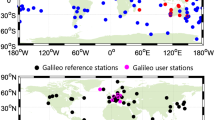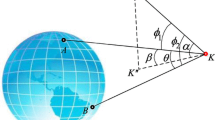Abstract
GPS precise point positioning (PPP) ambiguity resolution (AR) can improve the positioning accuracy and shorten the convergence time. However, for the BeiDou Satellite Navigation System (BDS), the problems of satellite-induced code bias, imperfections in the error models and the inadequate accuracy of orbit products limit the applications of the BDS PPP AR system, which requires more than 6 h to achieve the first ambiguity-fixed solution. In this study, the accuracy of a wide-lane (WL) uncalibrated phase delay (UPD) is improved after careful consideration of the code bias and multipath. Meanwhile, the accuracy of the BDS float ambiguity is also improved by multi-GNSS fusion and improved precise orbit and clock products, which are critical for high-quality narrow-lane (NL) UPD estimations. With three tracking networks of different scales, including Hong Kong, the Crustal Movement Observation Network of China (CMONOC) and the multi-GNSS experiment (MGEX) networks, the spatial–temporal characteristics of WL and NL UPDs for BDS GEO/IGSO/MEO satellites are analyzed, and the PPP AR is performed. Numerous results show that WL and NL UPDs with a standard deviation (STD) of less than 0.15 cycles can be achieved for BDS GEO satellites, while a STD of less than 0.1 cycles can be obtained for IGSO and MEO satellites. With the precise UPD estimation, for the first time, the BDS PPP rapid ambiguity resolution for GEO/IGSO/MEO satellites is achieved. We found that the average time to first fix (TTFF) of the BDS PPP AR is shortened significantly, to approximately 40 min for Hong Kong and the CMONOC, while the TTFF was 57.4 min for the MGEX networks. With ambiguity resolution, the accuracy of the daily BDS PPP in the east, north and vertical directions improves from 1.74 cm, 1.08 cm, and 5.52 cm to 0.72 cm, 0.54 cm, and 3.21 cm for the Hong Kong network, 2.24 cm, 2.31 cm, and 5.64 cm to 1.18 cm, 0.79 cm, and 3.30 cm for the CMONOC, and 2.71 cm, 1.80 cm, and 6.00 cm to 1.58 cm, 1.15 cm, and 4.33 cm for the MGEX networks. Significant improvement is also achieved for kinematic PPP, with improvements of 40.41%, 34.33% and 37.17% in the east, north and vertical directions for the MGEX networks, respectively.



















Similar content being viewed by others
References
Collins P, Lahaye F, Herous P, Bisnath S (2008) Precise point positioning with AR using the decoupled clock model. In: Proceedings of the ION GNSS. Savannah, pp 1315–1322
Dong D, Bock Y (1989) Global positioning system network analysis with phase ambiguity resolution applied to crustal deformation studies in California. J Geophys Res 94(B4):3949–3966
Feng Y, Wang J (2008) GPS RTK performance characteristics and analysis. J Glob Position Syst 7(1):1–8
Gabor MJ, Nerem RS (1999) GPS carrier phase AR using satellite single difference. In: Proceedings of the ION GNSS 1999. Institute of Navigation, Nashville, Tennessee, pp 1569–1578
Gao W, Gao C, Pan S, Wang D, Deng J (2015) Improving ambiguity resolution for medium baselines using combined GPS and BDS dual/triple-frequency observations. Sensors 15(11):27525–27542
Ge M, Gendt G, Rothacher M, Shi C, Liu J (2008) Resolution of GPS carrier phase ambiguities in precise point positioning (PPP) with daily observations. J Geod 82(7):389–399
Geng J, Teferle FN, Shi C, Meng X, Dodson AH, Liu J (2009) Ambiguity resolution in precise point positioning with hourly data. GPS Solut 13(4):263–270
Guo F, Li X, Zhang X, Wang J (2016) Assessment of precise orbit and clock products for Galileo, BeiDou,and QZSS from IGS Multi-GNSS experiment (MGEX). GPS Solut 21:279–290. https://doi.org/10.1007/s10291-016-0523-3
Han S (1997) Quality-control issues relating to instantaneous ambiguity resolution for real-time GPS kinematic positioning. J Geod 71(6):351–361
Hatch R (1982) The synergism of GPS code and carrier measurements. In: Proceedings of the third international symposium on satellite Doppler positioning at Physical Sciences Laboratory of New Mexico State University, Feb 8–12, vol 2, pp 1213–1231
Kouba J, Héroux P (2001) Precise point positioning using IGS orbit and clock products. GPS Solut 5(2):12–28
Li X, Zhang X (2012) Improving the estimation of uncalibrated fractional phase offsets for PPP ambiguity resolution. Navigation 65(3):513–529
Li X, Ge M, Zhang H, Wickert J (2013) A method for improving uncalibrated phase delay estimation and ambiguity-fixing in real-time precise point positioning. J Geod 87(5):405–416
Li X, Ge M, Dai X, Ren X, Fritsche M, Wickert J, Schuh H (2015) Accuracy and reliability of multi-GNSS real-time precise positioning: GPS, GLONASS, BeiDou, and Galileo. J Geod 89(6):607–635
Li P, Zhang X, Guo F (2016) Ambiguity resolved precise point positioning with GPS and BeiDou. J Geod 91(1):25–40
Liu J, Ge M (2003) PANDA software and its preliminary result of positioning and orbit determination. J Nat Sci Wuhan Univ 8(2B):603–609. https://doi.org/10.1007/BF02899825
Liu Y, Ye S, Song W, Lou Y, Chen D (2017) Integrating GPS and BDS to shorten the initialization time for ambiguity-fixed PPP. GPS Solut 21(2):333–343
Lou Y, Gong X, Gu S, Zheng F, Feng Y (2017) Assessment of code bias variations of BDS triple-frequency signals and their impacts on ambiguity resolution for long baselines. GPS Solut 21(1):177–186
Melbourne WG (1985) The case for ranging in GPS-based geodetic systems. In: Proceedings of the first international symposium on precise positioning with the global positioning system. Rockville, pp 5–19
Montenbruck O, Steigenberger P, Khachikyan R, Weber G, Langley RB, Mervart L, Hugentobler U (2014) IGSMGEX: preparing the ground for multi-constellation GNSS science. Inside GNSS 9(1):42–49
Montenbruck O, Steigenberger P, Prange L, Deng Z, Zhao Q, Perosanz F, Romero I, Noll C, Stürze A, Weber G, Schmid R, Macleod K, Schaer S (2017) The Multi-GNSS experiment (MGEX) of the international GNSS service (IGS)—achievements, prospects and challenges. Adv Space Res 59:1671–1697
Teunissen PJG, Joosten P, Tiberius CCJM (1999) Geometry-free ambiguity success rates in case of partial fixing. In: Proceedings of ION NTM 1999. Institute of Navigation, San Diego, pp 201–207
Wang G, Jong KD, Zhao Q, Hu Z, Guo J (2015) Multipath analysis of code measurements for BeiDou geostationary satellites. GPS Solut 19(1):129–139
Wang M, Chai H, Li Y (2017) Performance analysis of BDS/GPS precise point positioning with undifferenced ambiguity resolution. Adv Space Res 60(12):2581–2595
Wanninger L, Beer S (2015) BeiDou satellite-induced code pseudorange variations: diagnosis and therapy. GPS Solut 19(4):639–648
Wu X, Zhou J, Gang W, Hu X, Cao Y (2012) Multipath error detection and correction for GEO/IGSO satellites. Sci China (Phys Mech Astron) 55(7):1297–1306
Wübbena G (1985) Software developments for geodetic positioning with GPS using TI-4100 code and carrier measurements. In: Proceedings of the first international symposium on precise positioning with the global positioning system. Rockville, pp 5–19
Zhang X, He X, Liu W (2017) Characteristics of systematic errors in the BDS Hatch–Melbourne–Wübbena combination and its influence on wide-lane ambiguity resolution. GPS Solut 21(1):265–277
Zumberge JF, Heflin MB, Jefferson DC, Watkins MM, Webb FH (1997) Precise point positioning for the efficient and robust analysis of GPS data from large networks. J Geophys Res 102(B3):5005–5017
Acknowledgements
The contribution of data from MGEX is appreciated. This study was supported by National Natural Science Foundation of China (Grant Nos. 41774030, 41774034).
Author information
Authors and Affiliations
Corresponding author
Rights and permissions
About this article
Cite this article
Li, X., Li, X., Liu, G. et al. Spatial–temporal characteristic of BDS phase delays and PPP ambiguity resolution with GEO/IGSO/MEO satellites. GPS Solut 22, 123 (2018). https://doi.org/10.1007/s10291-018-0790-2
Received:
Accepted:
Published:
DOI: https://doi.org/10.1007/s10291-018-0790-2




